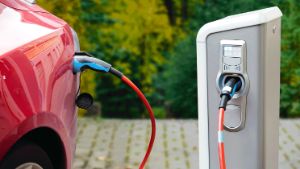We recently held an in-depth conversation about sustainability’s impact on the auto industry with three leaders in L.E.K. Consulting’s Automotive practice: François Mallette, Managing Director and practice head, Eric Navales, Managing Director, and Matt Wayne, Principal. Excerpts from our wide-ranging discussion can be found below.
What does sustainability mean in the automotive industry?
François Mallette: Sustainability in the industry takes many different forms. First on the list is tailpipe emissions. A significant amount of greenhouse gas is generated by the transportation industry. To address it, the industry is working on more efficient internal combustion engines (ICEs), electric vehicles and more mass transportation. Cities are starting to impose vehicle fees or restrictions to access crowded downtown areas such as London or Paris. The outlook for reducing tailpipe emissions in the U.S. over the next five, 10 and 15 years is very different than what it is expected to be in China, Europe and other parts of the world.
Second on the list is the sustainability of all the materials that are going into vehicles. They not only have to work well, but they are being made to be more sustainable, while being manufactured in a cost-effective manner. One interesting topic with electric vehicles today is the ability to recycle and dispose of electric vehicle batteries.
There are more ways in which the industry is tackling sustainability, of course, but those are two of the big ones — and given the size of the automotive industry worldwide, this is a very big subject.
We talked about other dimensions of sustainability — other than tailpipe emissions. What is the industry doing about those?
Matt Wayne: Some of the original equipment manufacturers (OEMs) are demanding sustainable practices of their suppliers. A cost of entry now to be able to engage with some OEMs is demonstrable sustainability. They are pursuing sustainability by forcing their suppliers to follow their rules.
On the topic of tailpipe emissions, what’s the solution? Electric vehicles?
Eric Navales: We have developed a framework to forecast the adoption of fully battery electric vehicles (BEVs). What is the outlook? There’s a general assumption that as soon as BEVs become readily available, consumers will buy them right away — that the penetration of electric vehicles at scale is inevitable. We’re questioning whether it is truly inevitable and over what time period it might happen.
There are barriers to BEV adoption. One barrier is range anxiety. For the most part, electric vehicles today don’t drive far enough (or are not perceived to drive far enough), and those that do are really expensive. For the average person, they’re not really an option. You need to get a longer range from the batteries. In the city and the suburbs, the current range may be enough, but if you live in a rural area and you’re used to driving 70+ miles somewhere and back, there are valid concerns over running out of electricity.
And you need to get the cost down. Ten years ago, the cost of a battery pack was $1,000 per kilowatt hour. Today it’s around $170. That’s dramatically better, but it’s got to get down to a point where BEVs are almost at price parity with ICE vehicles. One hundred dollars per kilowatt hour would start to get you there, except for less expensive vehicles, for which the cost would have to drop further. I think we might get to purchase price parity in the next five to 10 years. But it’s like any technology. It takes time for it to evolve.
Then there’s infrastructure. Where am I going to charge this vehicle? The charging infrastructure is a whole other investment that needs to be in place. If you can get BEVs to price parity with ICE vehicles, but you’ve got to spend another $1,500-$4,000 to put a fast-charging system in your house — well, now the cost equation has changed again. What if you don’t have a garage or carport? What if you park on the street because you live in an urban neighborhood? There are not enough public charging stations, or even private ones, for that matter. Are you ever going to have enough charging stations, and who’s going to pay for that?
Are the barriers to widespread electric vehicle use insurmountable?
Matt: We may get there eventually if battery technology takes hold as a long-term form of propulsion. But it won’t be sudden or overnight. You have to look at the mindset of the consumer, and, we believe, that’s the biggest barrier to overcome.
When you hear people say, “The hybrids have taken off,” remember, they account for less than 3% of the 278 million cars on the road in the U.S., and they’ve been available for a long time. The Prius is a tremendous vehicle, but if you look at the number of Priuses being sold, you’ll realize hybrids aren’t flying off the shelves. There’s a price issue with hybrids.
So, there are a lot of conventional internal combustion vehicles out there, and the average car stays on the road for 10 or 15 years. Change takes a while to work its way through. Even if the rate of sales increases, the transition to BEVs on the road will take a very long time in the U.S. Even if the government was to make the investment in infrastructure, the time to be able to capture the environmental benefits of that could be very long.
But will any manufacturers stick with ICEs?
François: I don’t think, as a car company, you can say, “I’m sticking only with the internal combustion engine.” You have to hedge your bets on propulsion technology given the global nature of the shift to electric, ever more stringent emissions regulations, the importance of being a good corporate/environmental citizen, etc.
You’re seeing companies like Volvo, for example, that have said that all their vehicles will be electrified by 2025.
What manufacturers are doing while pursuing BEVs is making the ICE better. The biggest factor responsible for reducing the consumption of gas in the U.S. is not the electrification of vehicles in operation, it’s the fact that ICEs are using less gas.
What about powering electric vehicles — what are the costs, and what’s the environmental impact?
Eric: The first challenge is generation capacity. If you wanted to electrify 30% of all vehicles in operation tomorrow, the capacity to generate that much electricity doesn’t exist.
Then, if you’re going to be environmentally sound, you have to ask yourself: Where does that electricity come from, how is it made, and what kind of waste will it generate? It has to be generated in large part by burning natural gas and coal. It’s important to talk about tailpipe emissions, but if you weigh the alternatives, accounting for the environmental impact of the BEV value chain, you have to consider the environmental effects from electricity generation all the way through battery disposal when the vehicles are scrapped.
What would cause the industry to finally “tip over” toward electric vehicles in the U.S.?
Eric: Lower prices, a broader selection of vehicles, consumer acceptance and, of course, regulation. It’ll be very interesting to see what happens now that there are an expected 50 to 80 new electric vehicle models coming to market in the next five years. There has been a limited range of BEV models for the last decade or so. Once there are models that people will be able to afford, can see themselves using and want to buy, we’ll see a greater percentage of electric vehicles on the road.
The Tesla Model 3 is a good example. It has the cool factor. It has a use case and form factor (midsize, four-door sedan) that easily fits into a typical U.S. middle-class lifestyle. And it came in at a starting sticker price of around $36,000, although most Model 3s had options that brought their sticker price closer to $50,000. Still, it was the No. 1-selling BEV in 2019. That shows you the importance of price, technology and design. Balancing all three is what will start moving the needle in the BEV field.
Some governments outside the U.S. have put in place policies that will force consumers to switch at least in part to BEVs. Except for California, there has not been much of a regulatory push in the U.S., but it will be interesting to see how California’s mandate that no new ICE vehicles be sold in the state beyond 2035 affects the BEV market.
In addition, it has become very expensive to develop a new vehicle platform. To spread those costs, OEMs are developing platforms they can sell worldwide. Since China and Europe have stricter requirements to lower tailpipe emissions, OEMs are building platforms to meet global emission standards.
What sustainability innovations have excited you?
Eric: Given that the installed base of internal combustion vehicles is going to be here for quite some time, the question is, how do you maintain, improve and eventually replace those ICE cars in a sustainable fashion? You need to think about the typical powertrain as well as all the associated subsystems, like the standard 12-volt lead acid battery that’s in most cars. Those lead acid batteries aren’t disappearing … in fact, there has been a lot of technological advancement with lead acid batteries. For example, enhanced flooded batteries (EFB) and advanced glass mat (AGM) lead acid batteries are critical to automotive engineers’ designs for lowering tailpipe emissions in ICE vehicles by enabling stop-start engine controls.
There are still a lot of investment opportunities in traditional car components to advance sustainability.
Will the push for sustainability change car culture in the U.S.?
François: You can argue that the car, in American culture, has been put on a pedestal. It’s hard to identify a country that idolizes the automobile more than the U.S.
Given that, what would have to be true for 30% of drivers in the U.S. to drive an electric vehicle? First, the fact that it’s electric has to become a non-issue — that means no range anxiety, no recharging headaches, etc. Second, great, beautiful cars have always appealed to people, so design and functionality will have to surpass those of ICE vehicles. Third, the price has to be right. Most people stretch to pay for their car and can’t afford to spend more on a BEV.
Will other trends and development in the industry have an impact on sustainability?
Eric: The big one is autonomy — the arrival of self-driving vehicles — and the related shift from individual to fleet ownership. I give it a 50/50 chance that my 5-year-old son will have to learn how to drive. Where could the world be in 11 years with respect to fleet-owned vehicles and autonomous vehicles? If people care less about driving themselves, if they care less about owning a car, then maybe those would become major factors in pushing rapid electric vehicle adoption because the high cost of buying a BEV could be borne by fleet owners that operate the vehicles 12+ hours a day. Low operating costs, in turn, would advance sustainability.
François: There are 278 million vehicles on the road in the U.S. What’s your car doing right now? It’s sitting there, right? If you have shared, autonomous vehicles, you’re not going to need all those vehicles. Instead of owning a vehicle, you could buy rights to have access to a vehicle that will come and pick you up, or use a ride-share. These will lead to much higher asset utilization. Then, you may have only 100 or 150 million vehicles on the road, and individual consumers are not deciding what kind of vehicles they are, the fleet owners are. That changes the decision-maker. That scenario is at least a generation away. But autonomy, by taking the consumer out of the equation, might make the industry less costly to the environment.





